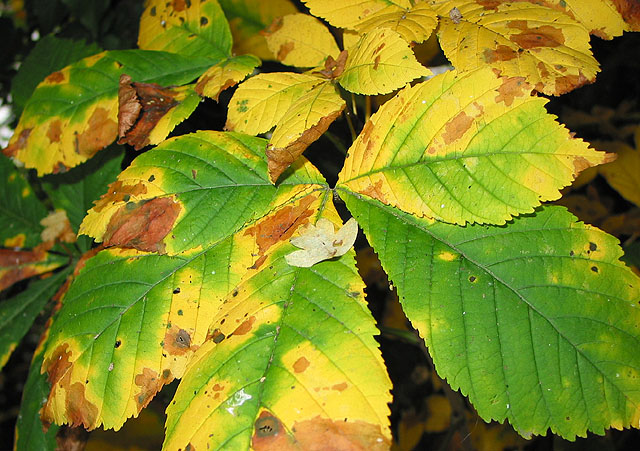we look, rather than overlook.
 |
| Horse Chestnut leaves on the banks of the River Wye. |
Autumn Leaves is a wistful tune sung by Nat King Cole and many talented singers.
Autumn Leaves
Johnny Mercer
The falling leaves drift by the window
The autumn leaves of red and gold
I see your lips, the summer kisses
The sun-burned hands I used to hold
Since you went away the days grow long
And soon I'll hear old winter's song
But I miss you most of all my darling
When autumn leaves start to fall
Translated to English from the 1945 French song Les Feuilles Mortes, i.e., "The Dead Leaves", the lyrics of Autumn Leaves expresses the longing we have for what we might have lost and for what we are about to lose.
Autumn is a rhythm of life. The earth's rhythms are plentiful and rewarding to those who observe them.
Earth's Rhythms
The word rhythm derives from the Greek ῥυθμός—rhythmos, meaning "any regular recurring motion, symmetry".
Rhythm describes a regular recurrence or pattern in time. Earth's rhythms appear in cyclical phenomena from microseconds to millions of years.
Time Scales
The rhythm of night and day is a Circadian Rhythm. The word circadian was coined by scientist Franz Halberg in 1959. It comes from the Latin words circa (i.e., around) and diem (singular of dies).
Halberg was a pioneer in Chronobiology (the study of biological rhythms, such as daily, tidal, weekly, seasonal, and annual rhythms). In the context of living organisms, circadian rhythms are both built-in and adjusted to environmental cues. Environment cues are called zeitgebers (i.e., a German word meaning synchronizers). One zeitgeber is daylight.
 |
| Relationship between ethological terms and parts of the day. |
- Diurnal (daytime);
- Nocturnal (night time); and
- Crepuscular (dawn and dusk hours).
Other Rhythms
 |
| Echelon flock formation of migratory birds |
Infradian rhythms are cycles longer than a 24-hour day. For example,
- the annual migration of birds;
- the varied reproductive cycles of animals; and
- the human menstrual cycle.
- the 90-minute REM cycle;
- the 4-hour nasal cycle of congestion/decongestion, and
- the 3-hour cycle of growth hormone production.
 |
| Tide pool in Portugal |
Tidal rhythms are cycles that emerge from the roughly 12-hour transition from high to low tide and back.
Gene oscillations describe a phenomena where genes are more active during certain hours of the day (acrophase) and less active in the time (bathyphase).
I'm so glad I live in a world where there are Octobers.Meditation
― L.M. Montgomery, from Anne of Green Gables
There is a measure of serenity in earth rhythms, the seemingly friction-less spin of the earth, and the earth's reliable orbit around the sun.
Nature's peace will flow into you as sunshine flows into trees. The winds will blow their own freshness into you, and the storms their energy, while cares will drop away from you like the leaves of Autumn.All existence seems a pulsating rhythm. I wonder if my heart pulsates in harmony the changing color of leaves. At some level, I think it does.
― John Muir
...if you become aware of the fact that you are all of your own body, and that the beating of your heart is not just something that happens to you, but something you're doing, then you become aware also in the same moment and at the same time that you're not only beating your heart, but that you are shining the sun. Why? Because the process of your bodily existence and its rhythms is a process, an energy system which is continuous with the shining of the sun, just like the East River, here, is a continuous energy system, and all the waves in it are activities of the whole East River, and that's continuous with the Atlantic Ocean, and that's all one energy system and finally the Atlantic ocean gets around to being the Pacific Ocean and the Indian Ocean, etc., and so all the waters of the Earth are a continuous energy system. It isn't just that the East River is part of it. You can't draw any line and say 'Look, this is where the East River ends and the rest of it begins.'References
― Alan Watts
- Chronobiology, Wikipedia.
- Circadian Rythym, Wikipedia.
- Chestnut Tree Circadian Clock Stops In Winter, Scientific American.



